Skip the store-bought and make homemade Easter candy this year! These Easter egg buttercream candies combine a thick and creamy buttercream filling with rich dark chocolate. Choose from a variety of flavors or stick with vanilla listed below.
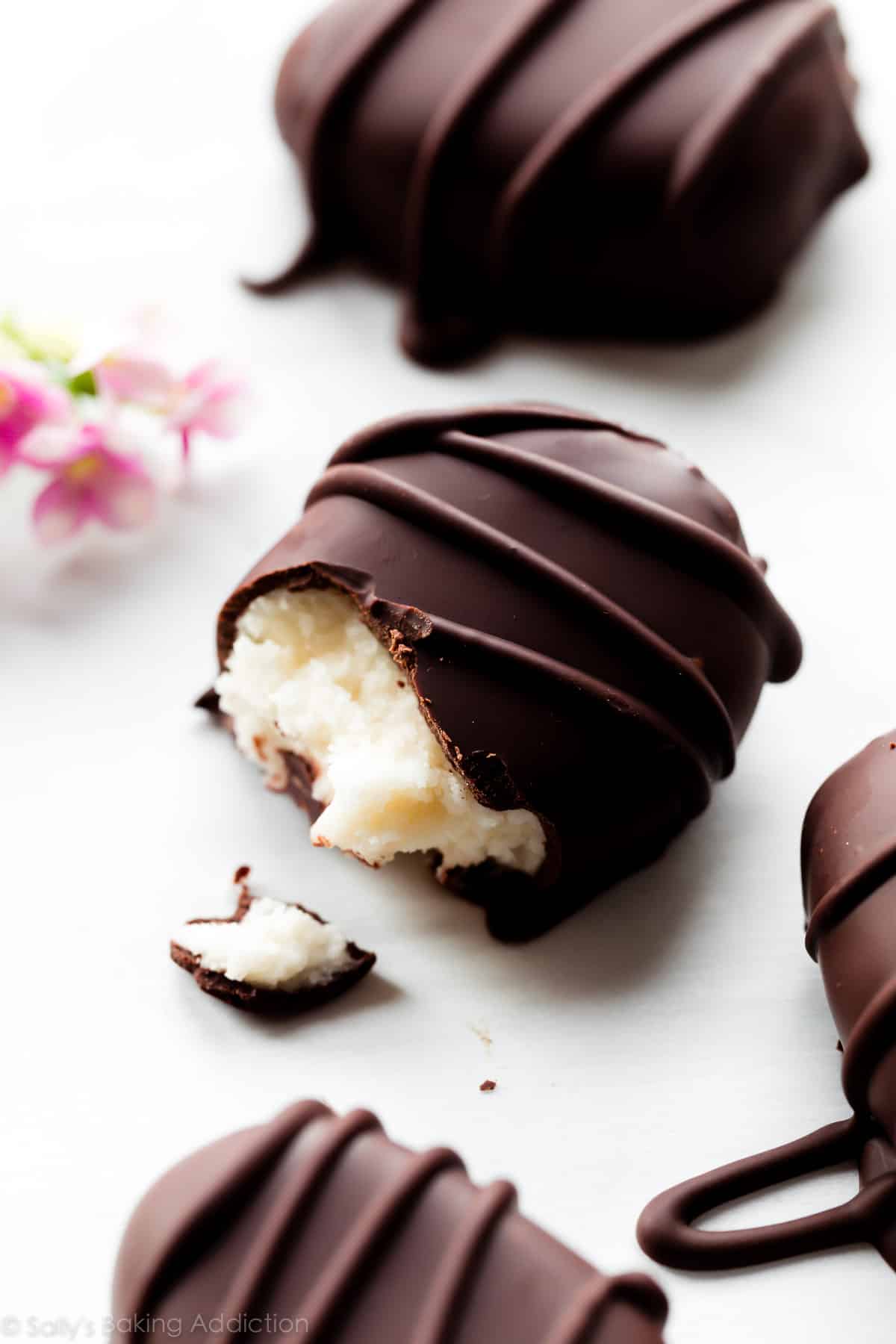
Most foods are improved with a simple dip in chocolate. Pretzels, strawberries, and even biscotti cookies. And buttercream is another we’ll add to the list! Yes, this is a buttercream-like filling covered in chocolate. Do your teeth hurt at the thought of all this sugar? If it makes you feel any better, we’re good friends with our dentist and she loved these. Ha!!
But that’s what candy is all about. It’s sugary, it’s sweet, and it’s perfect around holidays, including Easter. Instead of purchasing store-bought chocolate eggs filled with who-the-heck-knows-what, give these Easter egg buttercream candies a try. You can jazz up the buttercream filling with a variety of flavors or even add shredded coconut. Give them a dunk in chocolate and let each bite completely melt in your mouth.
Trust me, you’re going to be very happy about these.
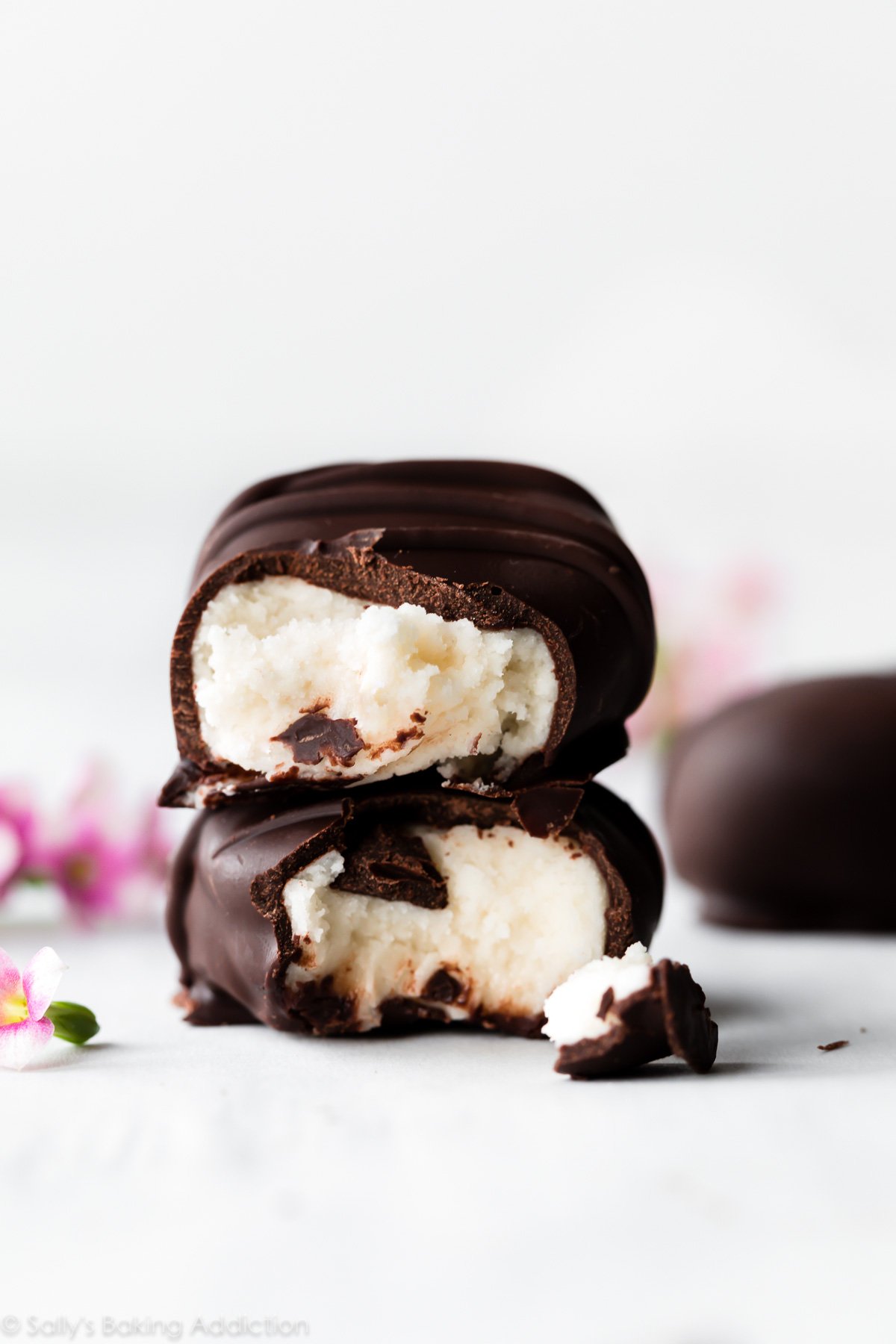
What Are Buttercream Candies?
Let’s chat a little more about this buttercream filling business. Do you know the vanilla buttercreams found in chocolate boxes? They’re absolutely delicious, remarkably creamy, and typically filled with fondant. I prefer a shortcut approach using butter and confectioners’ sugar. As a bonus, this shortcut method retains the same delightfully creamy consistency. I published a strawberry version in my cookbook Sally’s Candy Addiction. Today’s buttercream eggs are plain, but I definitely wouldn’t consider them boring! They’re flavored with a little vanilla and almond extracts and taste remarkable enrobed in dark chocolate.
This buttercream filling is not ideal for frosting a cake. It’s very thick and ideal for molding into shapes such as balls or Easter egg shaped candies.
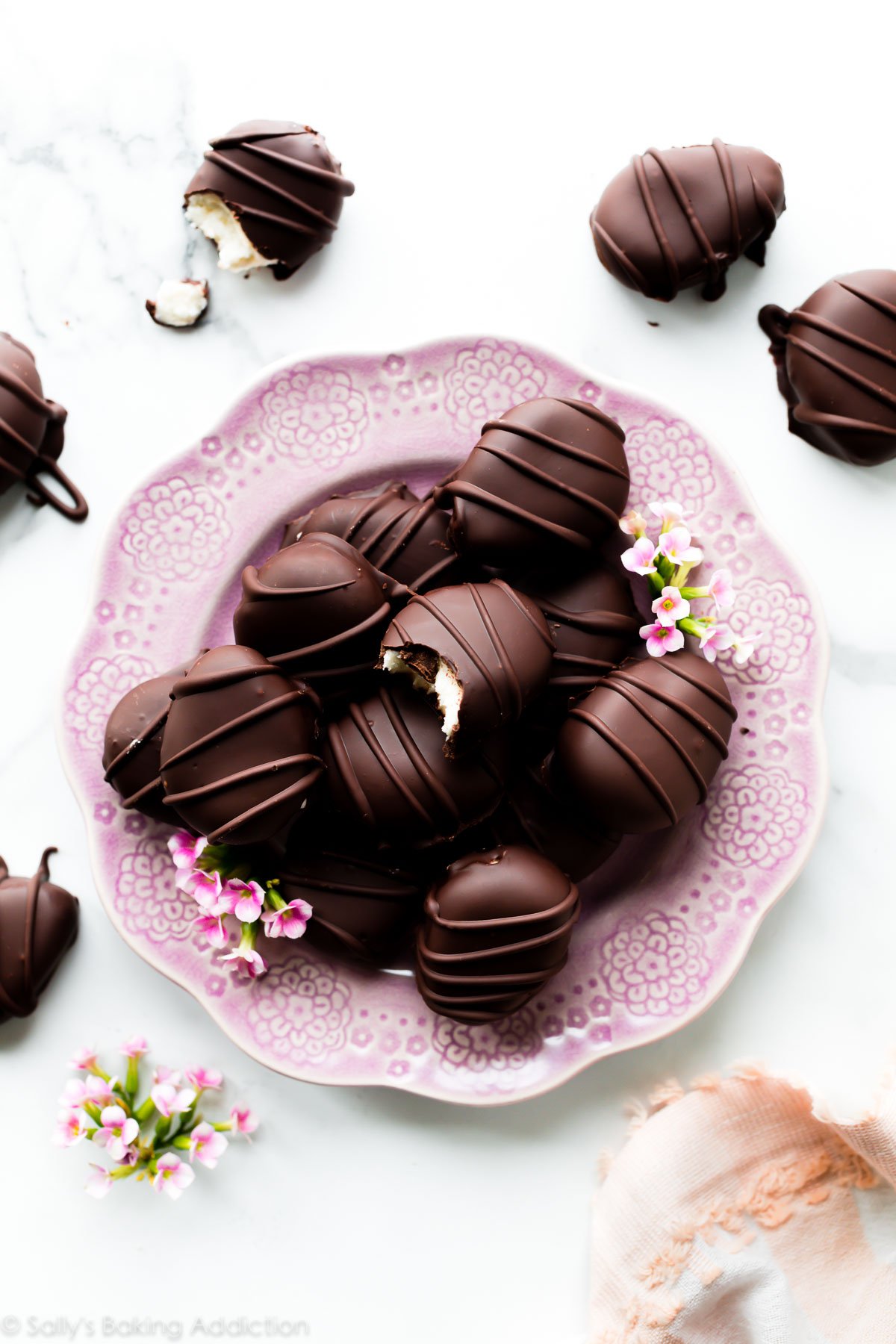
How to Make Buttercream Filling
Pretend like you’re making regular vanilla buttercream. We’re using the same exact ingredients, but different ratios to produce a mega thick filling. Start with room temperature butter and make sure it’s the proper room temperature. Not overly soft, not melted in the slightest, and still cool to touch. Good rule of thumb: let the butter sit out on the counter for 1 hour before beginning the recipe. You also need confectioners’ sugar, heavy cream or half-and-half, and flavorings.
Chilling: The most important part of this homemade Easter candy recipe is chilling. Chill the buttercream filling before shaping into Easter eggs. Otherwise it’s way too soft to mold into shapes. After molding the cold buttercream filling into Easter egg shapes, refrigerate again for at least 1 hour. The colder the buttercream, the easier it is to cover in chocolate.
Buttercream Candy Flavors
Keep the 1 and 1/2 teaspoons of vanilla extract in the recipe.
- Coconut Buttercreams: Replace almond extract with coconut extract and add 1/2 cup sweetened shredded coconut. If desired, pulse the coconut in a food processor so the shreds are smaller.
- Lemon Buttercreams: Replace almond extract with lemon extract.
- Chocolate Filled Buttercreams: Replace 2 Tablespoons confectioners’ sugar with unsweetened cocoa powder.
- Orange Buttercreams: Replace almond extract with orange extract.
- Strawberry Buttercreams: Pulse 1 cup of freeze-dried strawberries in a food processor to yield about 1/2 cup strawberry “dust.” Replace 1/2 cup of confectioners’ sugar with 1/2 cup strawberry dust.
- Coffee Buttercreams: Add 1 teaspoon espresso powder. Taste, then add more as desired.
- Peanut Butter Eggs: Use the recipe for these homemade peanut butter eggs.
Have fun with different extracts and flavors. You can even divide the buttercream filling up to make different varieties from 1 batch.
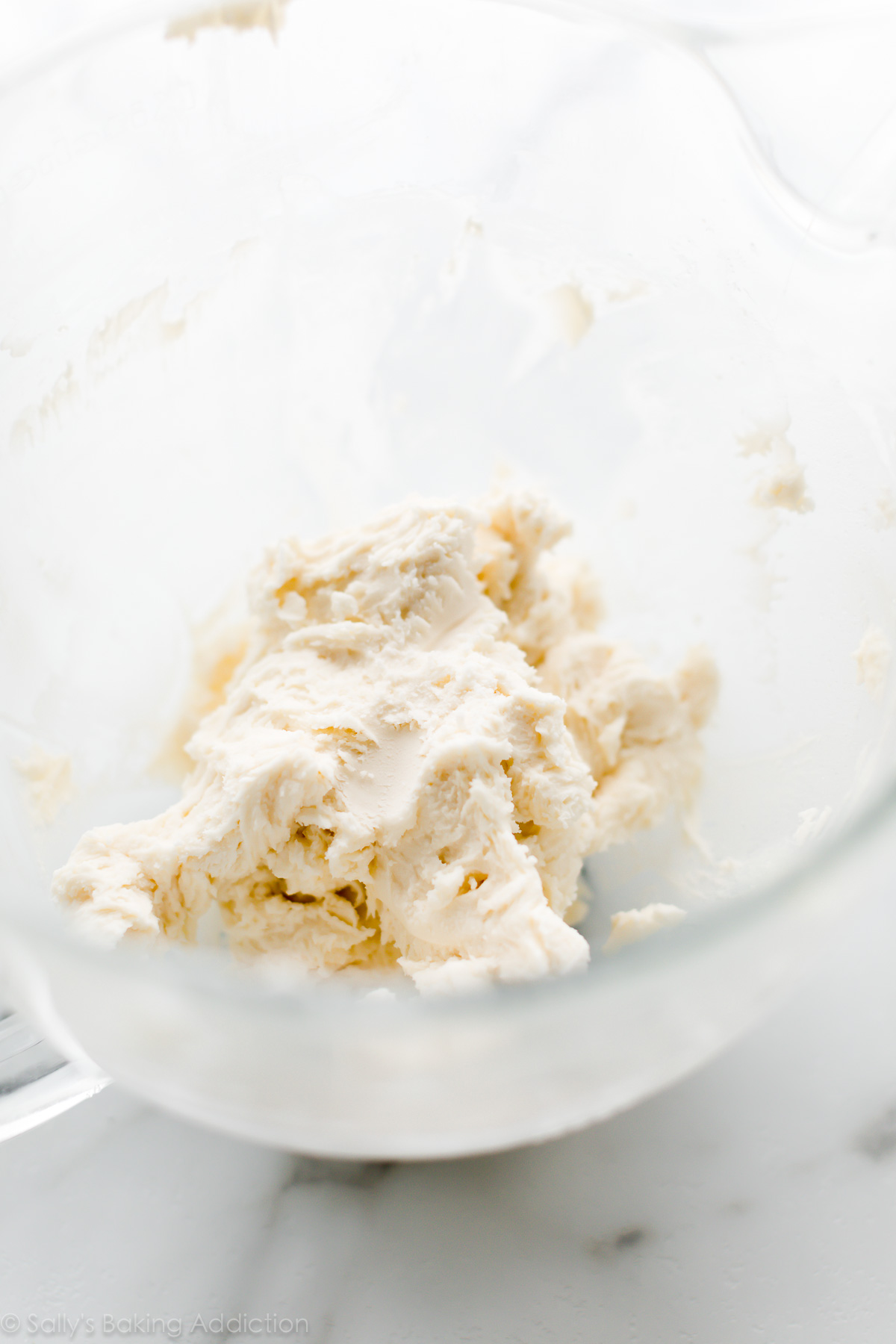
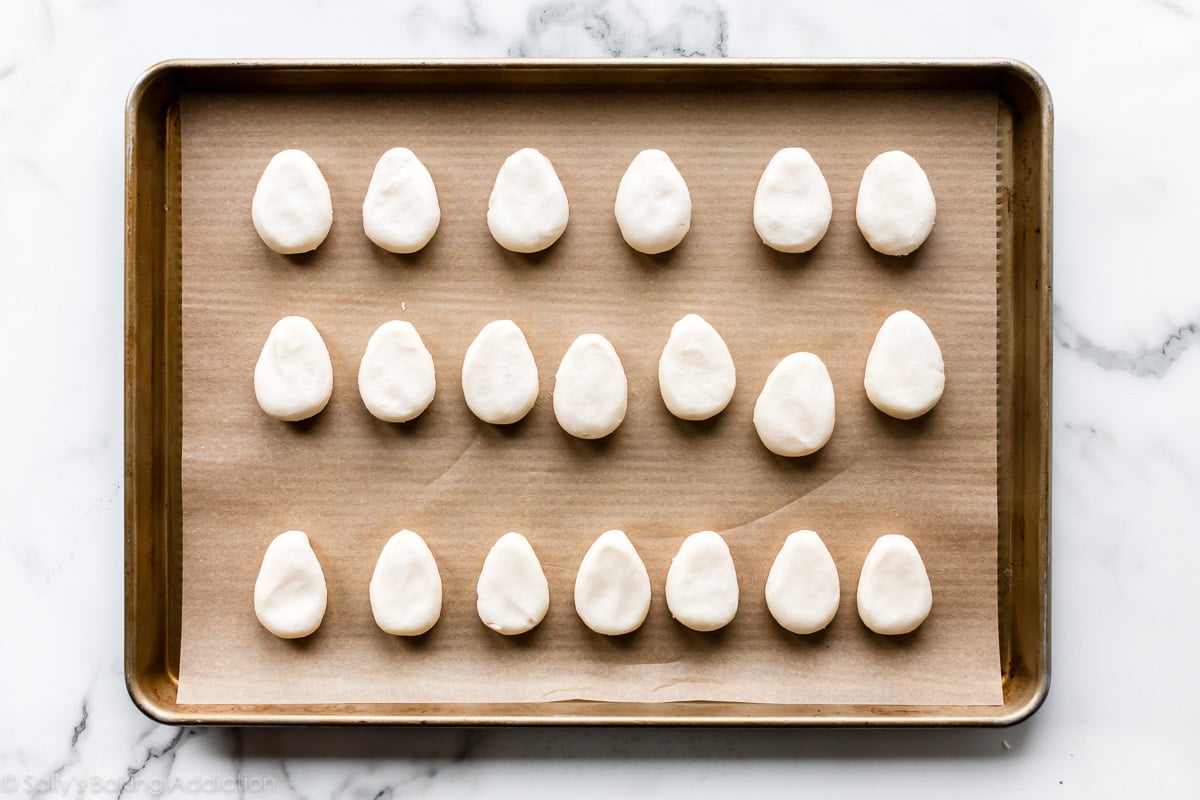
How to Shape Filling into Easter Eggs
Each Easter egg candy is 1 Tablespoon (about 1 ounce) of buttercream filling. When the filling is nice and cold, it’s much easier to shape. The filling gets a little crumbly, but the warmth of your hands brings it back together. First, roll the buttercream filling into a ball. Flatten it between your palms so it’s about 1/2 – 3/4 inch thick, then use your fingers to thin out one end for the top. It’s really easy and they certainly don’t need to be perfect.
This recipe yields about 20 Easter egg buttercream candies.
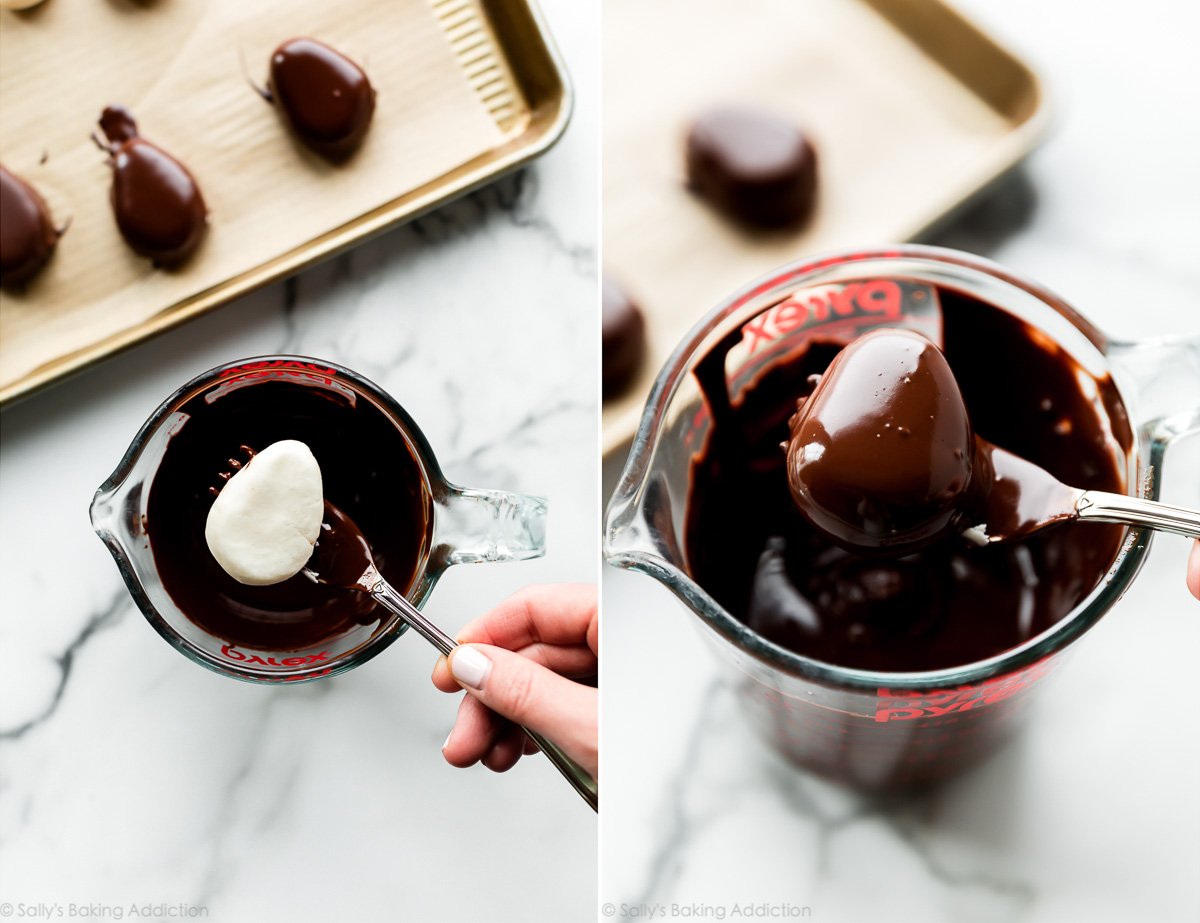
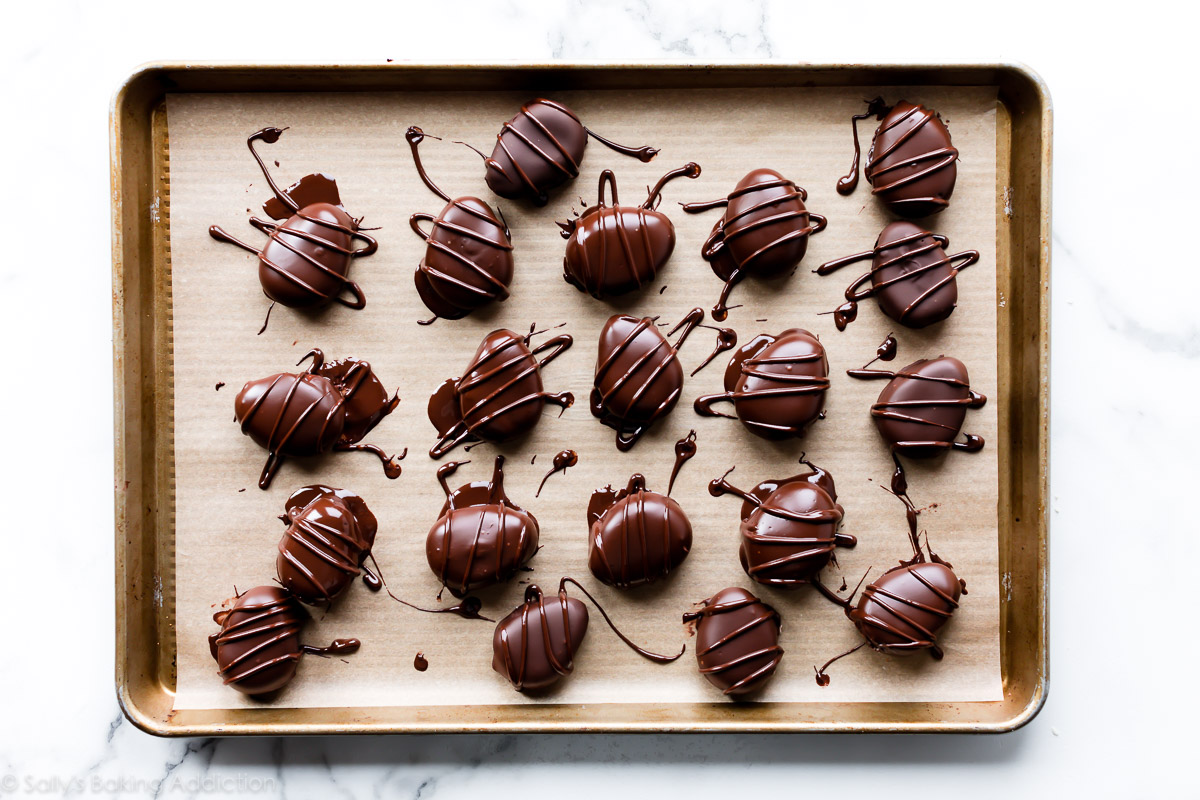
How to Dip Candies in Chocolate
- Use real chocolate. This is the most important step and the one that many people overlook. For the BEST looking and tasting candies, start with real chocolate. Use the 4 ounce “baking chocolate” bars found in the baking aisle. I prefer Bakers or Ghirardelli brands. You need about 4 four ounce bars for this recipe, 16 ounces total. You can use semi-sweet or bittersweet chocolate. A sweeter chocolate, such as milk chocolate or white chocolate will produce VERY sweet candies. Candy melts work too, but they don’t taste like real chocolate. Do not use chocolate chips. They contain stabilizers which prevent them from melting properly. Great for chocolate chip cookies, but not so great when we need smooth, melted chocolate like in this recipe.
- Melt the chocolate. You can use a double boiler or the microwave. Microwave in 20 second increments, stirring after each. Chocolate is temperamental, so always melt with care. I do not recommend tempering the chocolate for this recipe. Tempered chocolate should not be refrigerated and due to the fresh ingredients in the filling, these candies must be refrigerated.
- Let the chocolate cool down for a few minutes. Otherwise it will melt the buttercream.
- Dip the Easter eggs. While I prefer special dipping tools for round truffles, a fork works perfectly for these flatter candies. Submerge the buttercream into the chocolate. Carefully lift out with a fork. Tap the fork on the edge of the bowl to rid excess chocolate.
- Allow the chocolate to set. Place chocolate covered eggs on a lined baking sheet. If you have leftover chocolate, drizzle on top of each—just like you see in the photo above. Place the baking sheet in the refrigerator to set the chocolate.
I repeat: Do not use chocolate chips. They’re great for cookies, but since they contain stabilizers, they do not melt into the correct coating consistency.
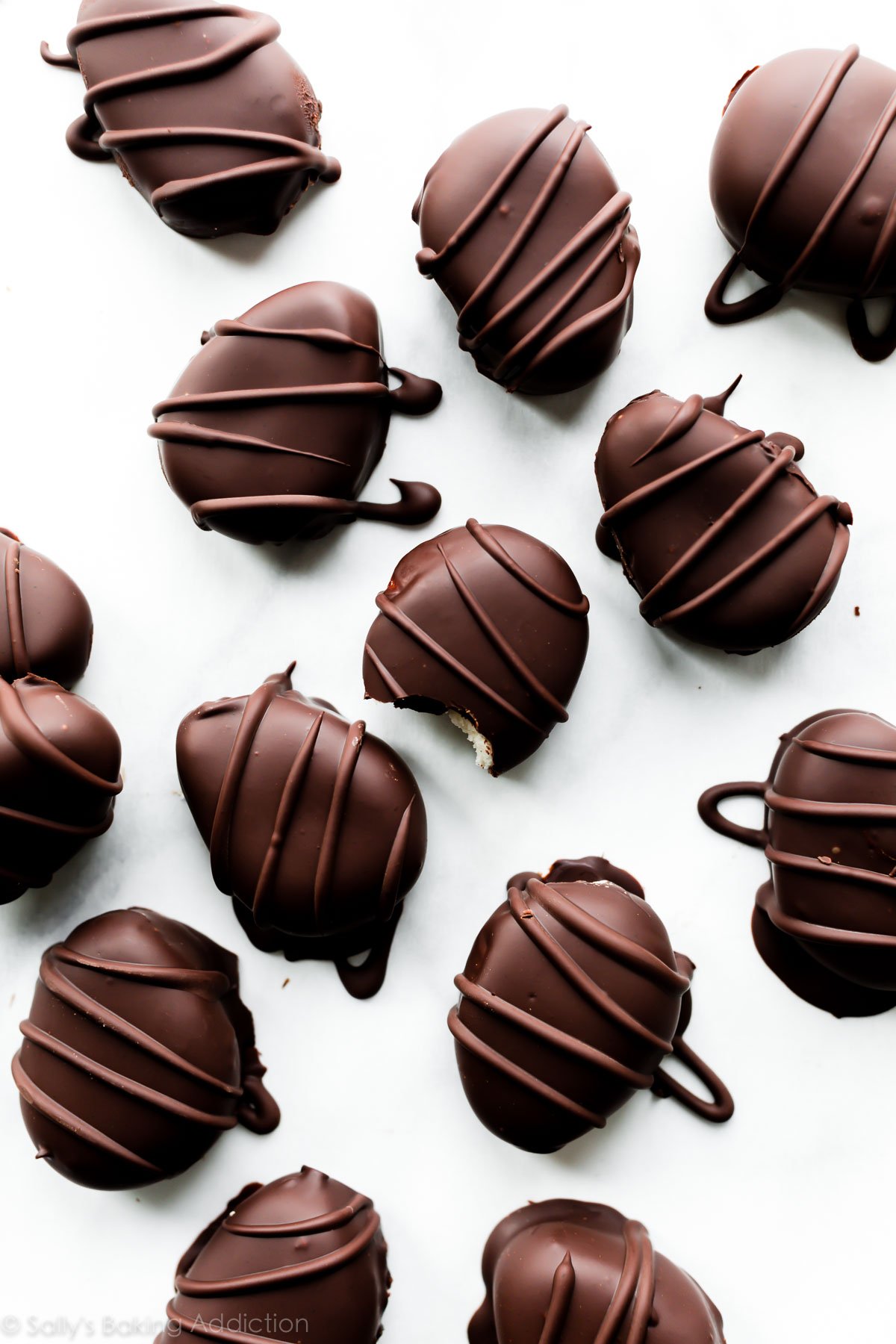
Coating in Chocolate – Troubleshooting
Your Easter egg buttercream candy is perfectly shaped and cold, but dipping them into chocolate is giving you some problems. Let’s work through them together.
- Chocolate is too thick: 1 teaspoon of vegetable oil thins out the chocolate so it’s the best consistency for dipping. If you find your chocolate is still too thick, add a little more vegetable oil. Coconut oil works too, but I prefer vegetable oil.
- Chocolate isn’t smooth on the candies: It was likely too thick. You want a very thin chocolate. See above.
- Chocolate is hardening before I’m finished: This is an easy fix! First, make sure you are working quickly. Second, keep the chocolate fluid by reheating in the microwave for 10 seconds or use a double boiler. If you don’t have a double boiler, spoon the chocolate into a glass bowl set over a pot of simmering water. This keeps the chocolate slightly warm. Don’t let the water touch the bottom of the glass bowl.
- Buttercream filling is melting: The chocolate is too hot. Let it sit for a few minutes to slightly cool down and then try again.
Have fun with these! We have some leftover in the freezer and, admittedly, I love gnawing on them frozen. The filling tastes like ice cream!
Looking for more Easter inspiration? See all 18+ of our favorite Easter brunch recipes. And here are 18+ Easter dessert ideas, including these adorable (and super easy!) jelly bean sugar cookies.

More Homemade Candy Recipes
- Chocolate Truffles
- Homemade Cake Pops
- Peanut Butter Balls
- Homemade Caramel Corn
- Peanut Butter Eggs
- No Bake Peanut Butter Bars
- 4 Ingredient Peanut Butter Fudge
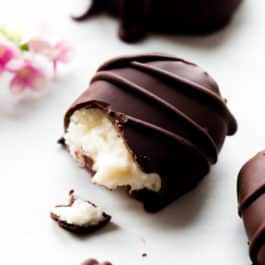
Easter Egg Buttercream Candies
- Prep Time: 2 hours, 30 minutes
- Cook Time: 0 minutes
- Total Time: 3 hours
- Yield: 20 candies
- Category: Dessert
- Method: Dipping
- Cuisine: American
Description
These Easter egg buttercream candies combine a thick and creamy buttercream filling with rich dark chocolate. Choose from a variety of flavors listed in the blog post above or stick with vanilla listed below. See blog post for extra tips on coating the buttercream candies with chocolate.
Ingredients
- 1/2 cup (8 Tbsp; 113g) unsalted butter, softened to room temperature
- 4 cups (480g) confectioners’ sugar
- 3 Tablespoons (45ml) heavy cream or half-and-half
- 1 and 1/2 teaspoons pure vanilla extract
- 1/2 teaspoon almond extract
- pinch salt, to taste
- four 4-ounce semi-sweet chocolate bars (450g), coarsely chopped*
- 1 teaspoon vegetable oil
Instructions
- In a large bowl using a handheld or stand mixer fitted with a paddle attachment, beat the butter on medium speed until creamy, about 2 minutes. Add the confectioners’ sugar and beat on low for 1 minute. Add the cream, vanilla and almond extracts, then beat on high for 3 minutes or until completely smooth and creamy. Taste, then beat in a pinch of salt if needed. (It’s supposed to be very sweet!) The mixture will be very sticky. Cover the bowl tightly with aluminum foil or plastic wrap and chill in the refrigerator for at least 1 hour and up to 1 day. Chilling makes shaping the buttercream filling a little easier.
- Line 1-2 large baking sheets with parchment paper or silicone baking mats. Set aside.
- Once chilled, remove the mixture from the refrigerator. Scoop 1 Tablespoon of the buttercream mixture and roll into a ball. Flatten the ball between your palms and use your fingers to thin out one end into an egg shape. The egg should be roughly 1/2 – 3/4 inch thick. Place on the prepared baking sheet. Repeat with remaining buttercream mixture. The buttercream mixture may be a little crumbly, but the warmth of your hands will bring it together. If you find the buttercream mixture becoming too soft to handle, chill in the refrigerator for 15 minutes. Alternatively, you can powder your hands with confectioners’ sugar, which helps prevent the buttercream from sticking to your hands.
- Chill the shaped buttercream eggs in the refrigerator for at least 1 hour and up to 1 day. During the last few minutes of the chilling time, begin melting the chocolate and oil together. You can melt it in a double boiler or the microwave. If using the microwave: place the chocolate and oil in a medium heat-proof bowl. I recommend using a liquid measuring cup because its depth makes dipping really easy. Melt in 20 second increments in the microwave, stirring after each increment until completely melted and smooth. Let the warm chocolate sit for 6-8 minutes to slightly cool before dipping, otherwise it will melt the buttercream filling.
- Remove buttercreams from the refrigerator. Working with 1 at a time, submerge into the chocolate, then carefully lift out using a fork. Tap the fork gently on the side of the bowl/measuring cup to rid excess chocolate. Use a toothpick or a 2nd fork to help you slide the buttercream off of the fork and onto the baking sheet.
- If you have leftover chocolate, drizzle over candies. I reheated the chocolate and used a squeeze bottle to drizzle.
- Refrigerate buttercream eggs for 30 minutes or until chocolate has completely set before serving.
- Layer buttercream eggs between sheets of parchment or wax paper and store in an airtight container in the refrigerator for up to 2 weeks.
Notes
- Make Ahead & Freezing Instructions: You can start this recipe 1 day ahead of time. The shaped filling can be chilled in the refrigerator for up to 1 day prior to coating. The coated buttercream candies can be frozen. Freeze the coated candies for up to 3 months. Thaw overnight in the refrigerator.
- Special Tools (affiliate links): Electric Mixer (Handheld or Stand) | Baking Sheets | Silicone Baking Mats or Parchment Paper | Double Boiler or Liquid Measuring Cup | Squeeze Bottle
- Chocolate: For the best looking and tasting candies, use 4 ounce “baking chocolate” bars found in the baking aisle. I prefer Bakers or Ghirardelli brands. You need about 4 four ounce bars for this recipe, 16 ounces total. You can use semi-sweet or bittersweet chocolate. A sweeter chocolate, such as milk chocolate or white chocolate will produce VERY sweet candies. Candy melts or almond bark work too, but they don’t taste like real chocolate. Do not use chocolate chips, as they contain stabilizers preventing them from melting into the correct consistency for coating.
- Coating/Melting Chocolate: See all my troubleshooting tips in the post.
- I do not recommend tempering the chocolate for this recipe. Tempered chocolate should not be refrigerated and due to the fresh ingredients in the filling, these candies must be refrigerated.





















I made this with maple flavoring and it was so good. Maple candy is my favorite candy but it’s hard to find.
Thanks to you I can have it any time I want and your recipes have never failed me yet.
I have a lot of leftover melted chocolate. Recommendations of how to use it? I have already striped the tops of the eggs. Thanks!
Hi Laira, if you’re looking for a simple way to use the leftover chocolate, you could dip pretzels in it for chocolate covered pretzels, or spread it flat on a covered baking sheet and top with candy for a bark. Hope you enjoyed the buttercream eggs!
Hello, can this recipe be halved successfully? Thanks!
Hi Kim, that shouldn’t be a problem. Enjoy!
If I wanted to make an orange or raspberry or lemon flavoring, what would flavorings would you suggest for the orange and lemon, use oil flavoring or extract. And how much flavoring of the orange lemon or raspberry?
Hi Carol, for the orange and lemon flavors, see the pink “Buttercream Candy Flavors” box in the post. For raspberry, we’d follow the directions for strawberry buttercreams, but use freeze-dried raspberries in place of the strawberries. Have fun!
Are the finished eggs shelf stable or do they need refrigerated? I was looking for something to what I see many churches in our area make and sell around Easter as a fundraisers. Most online recipes have cream cheese but these do not so I am hopeful they do not need refrigerated and we can gift to family members for Easter. Thank you!!
Hi Larisa, we do recommend refrigerating these candies. Hope you enjoy them!
These look great… Can I use a silicone candy mold for the buttercream?
Hi Carol, can’t see why not!
Would you recommend doing this with a ten year old? Have not tried this but I’m looking for cute Easter sweets!
Hi Eliana, you certainly could tackle this together! Or here are some of our other favorite kid-friendly recipes.
Do you have to use unsalted butter? I never buy it and normally just use my regular butter, should I not be doing that?
You can use salted butter, with no changes to the recipe. You may just need less added salt, to taste.
Made 200 of these with my daughter to hand out for Valentine’s Day. Shaping the buttercream was impossible for us so we used small silicone molds. Lined the molds with chocolate, piped in the filling, and then added a chocolate bottom. Made orange, lemon, raspberry, mint, and vanilla – raspberry and mint were our favorites. They were a hit!
I’m going to try making these soon! Do you have a recipe for something like Sees divinity candies or if not, would you consider developing one? Thanks!
Hi Jacqui, what a great recipe suggestion. I haven’t made divinity in years. Let me know how you like these buttercream candies!
Was looking for variations to my current butter cream recipe and came across yours. I have used cream cheese in mine to reduce the sugar and they’ve set up fine, a bit sticky to roll out but not terrible. I was questioning your advice against chocolate chips, that’s what I always use for dipping. I add about a tablespoon of shortening and melt in slow increments in the microwave. It’s always worked and we much prefer the flavor over the melting wafers.
I am not a fan of almond extract. Could I leave it out?
Yes, absolutely.
What brand or type of butter is recommended ? I used a good brand of butter, but the filling wasn’t butter tasting. It just tasted like sugar.
Thanks for the recipe! I was wondering if it would be possible to use leftover buttercream frosting?
Hi Stephanie! I’m unsure if the buttercream frosting you are using is thick enough to roll/shape and dunk in chocolate. You can certainly test it, and maybe even add some more confectioners’ sugar to thicken. For best results, I recommend using the recipe given.